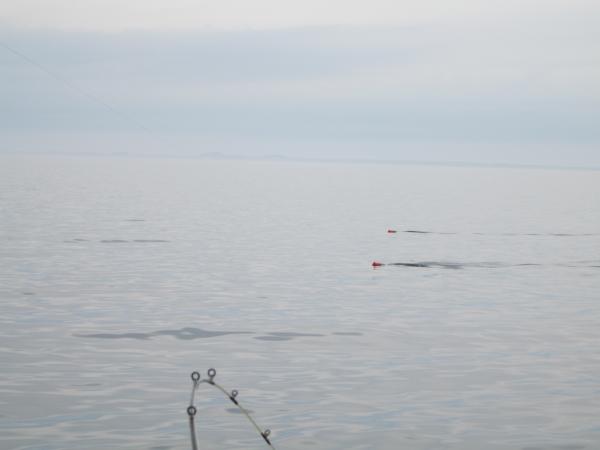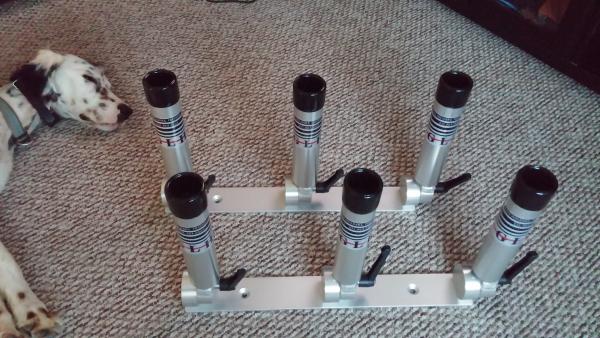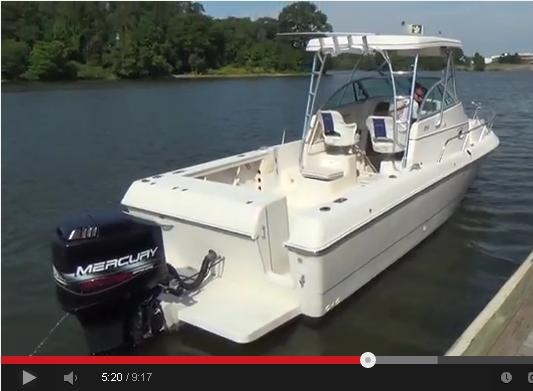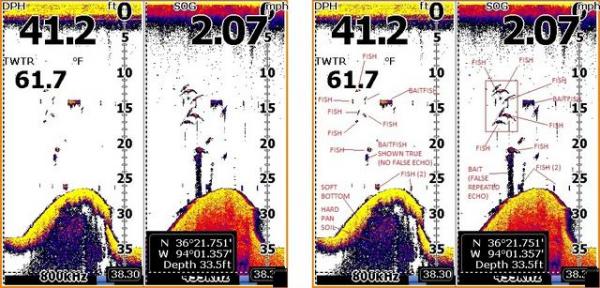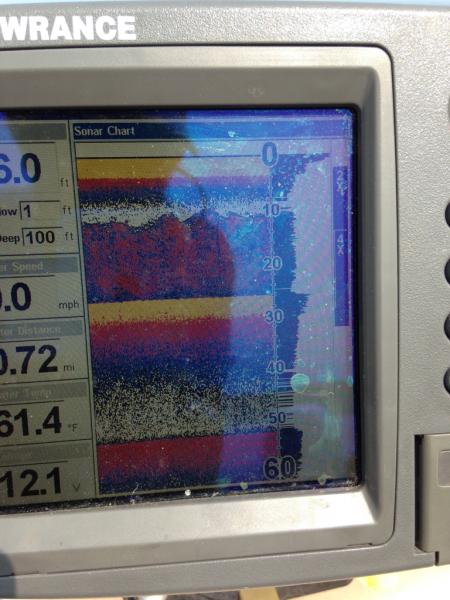-
Posts
844 -
Joined
-
Last visited
Content Type
Profiles
Forums
Events
Store
Gallery
Everything posted by SeaCatMich
-
Plugs will run successfully at almost any speed. In the fall when the salmon are staging I run a lot of plugs and troll in the 1.8 to 2.2 mph range when fishing right off the river mouths. This is also a great speed for dodgers and a dodger/squid is also good for staging fish. Offshore I will also put out plugs but run more in the 2.4 to 2.8 mph on the downspeed -- right along with flasher/fly or flasher/meat rigs and spoons. Silver Horde and Ace High plugs seem to work better than the J-plugs at the faster speeds.
-
Set the drags on your reels just a little tighter than what it takes to keep line from leaking during straight line trolling. You should hear an occasional tick from the clicker reels on the outside board rods in a turn. With the drags set that way the boards should pull backwards and you should hear the clicker as drag is pulled on the reel with most hits without the Tattle Flags. Also watch the board position as on small fish they will get pulled out of formation but might not take drag.
-
No real difference in running copper vs leadcore except that the copper is heavier per foot so it takes less to get the lure down to the same depth. Off the board you still let all of the weighted line out and then clip the board to the backing. If you run the same weight of line (say 300 leadcore or 150 copper) then the board is going to behave basically the same. If you run a 250 copper off the same board, it is going to sag in the rear if you don't offset the additional weight pulling on the back of the board by moving the board's lead ballast forward. Not sure what you mean by "when the board is mostly under water"? I run my Church Walleye boards with 300' copper 45# in 3' seas with no problems. Maybe your rods tips are not high enough -- you don't want any of the line from the rod to the board hitting the water. Maybe you are letting the board out too far to the side of the boat. But whether it is an Offshore or a Church board, it should not be under the water. In fact in bigger waves I have more problems with the boards skipping across the top of the water -- not being under it. The AA mod is more about having the board release from the front and stay pegged on the rear than it is the actual release used on the front. If you do go with the Sam's Release on the front, it adds length to the arm just like a big split ring does in the BloodRun/1Maniac mods. You still might want to angle the arm up to level the board as they describe. The "standard" OR18 on the front and the OR16 with the pin on the rear will work too in the AA setup. I'm not sure how it would work with the Tattle Flag setup though as with BR/1Maniac mods and AA mods the rear release should be moved up on the board while the Tattle Flag keeps it in the factory location.
-
The Offshore "yellow" "walleye" boards are the ones that 1Maniac is referring to for the mods and being able to run up to 300' of copper. The TX44 is a bigger board (made by Church not Offshore) and will pull heavier weighted lines like the 300'+ of copper better. There should be no reason that you can't run a full leadcore (300') behind the Offshore "walleye" board. Offshore "walleye" size board: Note: there is a board made my Church (not Offshore) that is named the Walleye Board. Size wise it is about the same size as the Offshore board. Offshore has just recently brought out a bigger board to compete with the TX44. Church Walleye board: As for detecting strikes on the boards, it sounds like you are using the "tattle flag" setup on your Offshore Boards. Most that use them for salmon don't rely on the flag to detect strikes. If you have the boards configured to not release on a strike, a fish should pull the board back in the spread and generally any fish over 3# should pull drag on the reel (assuming your drag is set loose enough and the clicker is on). If you have the board set to release and slide down the line on a strike, you should again see it fall backwards out of the spread. In addition to the Jim and Gregg's setup techniques in the BloodRun blog, I would recommend viewing this YouTube how-to that the guys over at Anglers Avenue made on setting up the Offshore boards to stay on the line but not slide. Might be a very good way to improve your setups.
-
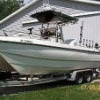
Looking to get ratchet rod holders
SeaCatMich replied to Carl.j.o's topic in Boat Maintenance and Rigging
-
Couple more notes on meat rigs. With flashers and flies the flasher actually gives action to the fly. With meat rigs the bait head and meat itself is what really gives the action. The flasher is more to attract the salmon by fooling it into thinking that another salmon is feeding on a school of bait. This is the main reason that the stretch from the flasher to the lure is much longer with a meat rig. It is also important that the roll of the meat head is not completely uniform. There should be a "kick". Think about how a wounded bait fish swims. It does a flip of the tail and then the body follows with a spin then it gets enough energy to flip the tail again. It is sort of hard to describe but you want the head to do this too... not just spin. The meat heads from both Big Weenie and John King are designed to do this out of the package while other brands require you to rig the bait correctly to get a bend that will do the roll with the "kick".
-
Sorry, said it backwards. Should be a rotation every 2-3 seconds.
-
The main thing I have found in running meat is that you want it to spin/rotate at around 2.5 to 3 times per second. Out of the package I have found that the Big Weenie spin correctly at 2.5 to 3.0 mph X4 downspeed. The John King heads work spin better out of the package at 1.8 to 2.2 mph speeds. Some heads need tuning to run with the correct rotation rate at any speed -- bending the head and/or putting a bend in the herring. Since I generally run a mixed lure spread and most of those lures run better at the 2.5 to 2.8 mph I prefer the BW rigs.
-
Integration between brands is much better now than in the past -- NMEA2000 is much better than the older NMEA0183 -- BUT it is still limited depending on what you want it to do. Most companies have gone to integrated multi function head units/displays where one screen can be used to display sonar/fishfinder, radar, chart plotting, engine monitoring and even autopilot information. Most now support multiple displays networked on their medium to high end lines. Various brands/models will definately be better than others for specific functions -- for example Garmin is highly regarded for GPS; Raymarine, Furuno,and Simrad for deep water sonar... Lowrance while good for fish finder and gps isn't so highly regarded for autopilot or radar. I would start by determining what is the most important feature for you -- fish finder, gps, charts, radar, auto pilot -- and then what features are absolutely "must haves". For example, maybe you want to have built in trolling patterns on the autopilot; or radar overlay on the chart; or a specific map product supported; or AIS integration for the VHF radio or viewing sonar/downvision/sidevison all on the screen at the same time... Narrow the field by which ones do/don't provide that feature and then look at prices and how the individual units work -- ie: are they easy to use and work the way you think intuitively. Another factor may be if there is any of the existing electronics you want to keep. How/If it will integrate into a new setup may narrow your choices. Early this summer I won a new Raymarine MFD (a78) and that was the deciding factor to push me over the edge upgrade my 10+ year old system. The main components I already had were Raymarine (fish finder, radar, autopilot... with Standard Horizon VHF and GPS/Charting interfaced w/ NMEA0183) and I was very pleased at how they worked. The old system had 3 displays (console, stern, bow) so to replace I needed to buy 2 new displays and a new radar dome. The new stuff is not yet installed due to some unforeseen medical issues, but I think it will be great. I probably would have stayed with Raymarine even if I hadn't won the new setup because I had good results from it and liked their tech support. The only think I am aware of it won't do that would be nice is forward scanning sonar... but the its cost wasn't going to have me getting that anyway.
-
I mainly have them work best in low light conditions -- the glow sticks in the old Northport Nailer glow plugs caused them to rattle plus the glow and were great for dawn/dusk. I would think that they would be good for leadcore/copper long lines too where the lure is away from the main spread and help the salmon hone in on its location.
-
What is the brand & model of the fish finders you have?
- 4 replies
-
- echo
- fishfinder
-
(and 1 more)
Tagged with:
-

Visiting Chicago last week of sept.
SeaCatMich replied to DINKY's topic in Indiana Waters Fishing Reports - Salmon and Trout
It really depends on the weather but late Sept could be hit or miss for bigger salmon in that part of the lake. Not too many streams for the fish to stage off of. But, still good fishing for a mixed bag of Kings, Coho, and Steelhead. My only experience with a boat in that area (actually a little north) is Dan Keating who owns Blue Horizon Sportfishing out of Winthrop Harbor -- http://bluehorizonsportfishing.net/ If there are fish to catch Dan will know where. Fun guy to go fishing with too. Call soon to get on the calendar. Lake Michigan fish size is generally smaller than Ontario. Kings in the 20-25# range are not unusual but over 30# is. Numbers per trip are down from past years but it isn't unusual. More of a mixed bag fishery with Kings, Coho, Steelhead/Rainbow, and Lake Trout... with some Browns thrown in. -

Port Sheldon 8/9 pm
SeaCatMich replied to Blackhawk's topic in Michigan Waters Fishing Reports - Salmon and Trout
Secret Weapon Rig -- short (1, 2, 3 color) segment of leadcore run off of a a low downrigger. The leadcore runs a few feet under the downrigger ball and 60 to 100' back as a stealth approach. Because it runs below and sinks even more on turns, it generally is run on the lowest downrigger. Can run two but need to have horizontal separation between the riggers. Got the name when my buddy Dave Mull teased the technique on the GLA website as the name for an upcoming article in the magazine about 12 years ago. It go shortened to SWR. It works, so the name stuck. -

Clean Power Plan is tremendous opportunity for Michigan
SeaCatMich replied to News's topic in Great Lakes News
The United States has been the global leader in regards to reducing pollution since the 1970s. Even if all fossil fuel pollution was eliminated in the US it would be an insignificant reduction compared to what is being generated in China, India, eastern Europe... Sorry, but it doesn't add up to cripple the US energy supply and/or cost to require us to use expensive "politically correct" energy such as solar and wind instead of coal and natural gas. Especially if the rest of the world isn't gong to as well -- when along with nuclear, those are the fuels we have in abundance -- sort of amazing how that is a coincidence. Somehow I feel that the UN will find issue with wind and solar and wave power too once they figure out that the USA with more flat land for solar and wind, and more coastline for wave energy will somehow be bad too. Eventually it is possible that solar and wind could be significant contributors to the country's energy base but not now and they are not even remotely competitive without significant government subsidies -- government subsidies which is a PC way of saying that the "government is paying for it" and since the government does not really have money, it has MY TAX DOLLARS, it is still us in the general population paying the higher cost. -

BEWARE of fake seaguar flourocarbon leader line
SeaCatMich replied to brokeoff's topic in General Discussion
Nice ideas in that link but it is not eBay policy. It is a "how to" written by an eBay member (actually a former eBay member) and is from Great Britain. Even the link they say to go to is UK based but no longer active. As with all purchases one of the keys to getting a situation like this resolved -- especially through eBay -- is to report the problem quickly. On eBay you have 60 days after the purchase to leave feedback and contest a purchase if it is not as advertised. What has frustrated me in the past has been when I contact the seller and don't get a quick resolution within that 60 day period. Consequently I now start with a complaint immediately -- it is also amazing how a seller responds much faster with an official eBay or PayPal complaint than just to bad feedback or direct contact. Here is the actual way it should be done: http://ocsnext.ebay.com/ocs/sr?query=1735&st=7&trackPos=5 -
I have had good luck working with Marc's Marine up in Eagle (just north of Grand Ledge). Has been outboard work for me so I don't know if he does I/O or not but would be worth a call (http://marcs-marine.com/). I would not recommend Bee's up in St. Johns -- over priced and slow. Grand Pointe up in Lansing seems good, but is expensive. There is a freelance guy in Lansing that advertises on CraigsList. He knows his stuff but comes across a little fly-by-night. He did some work for me on a couple outboards and no issues though. I think his name is Steve.
-
Not really negative, I just don't like it jumping between scales a lot. Auto range is great if the bottom isn't moving around a lot. Much of the time I am also usually fishing in/out (E/W) to try to find fish in different depths of water and with auto range it has it moving all over the place. Same thing when I'm weaving a shelf like off Ludington up to Frankfort, when going from 70 to 120 I prefer to have the bottom set on 150 rather than having it jump around. Another thing is that I often fish in deeper water (250'+) but the fish are typically not that deep. So I will have my main display showing a range in the water and not the whole column... say 30' to 150 if the downtemp allows me to eliminate that water. I typically don't worry about the top 20' of water in summer as far as marks -- but will put some board rods up there for steelhead if I have enough people onboard.
-
10 years ago I would have agreed. Most newer units are much more efficient though and don't require that much gain. I don't use Lowrance (and haven't in many years) but from what I have seen, they have both power/gain settings and sensitivity plus lots of other settings. The one setting I wouldn't ever rely on is automatic. Put it in manual mode and then start tweaking things.
-

BEWARE of fake seaguar flourocarbon leader line
SeaCatMich replied to brokeoff's topic in General Discussion
Too many people on eBay provide feedback only on the price and how fast an item ships. They put the feedback up before actually using the item. If you check this seller's feedback it sure seems to be the case. No real comments (outside of what I assume is brokeoff's) about the product itself. Too many people out there that probably can't even tell the difference between mono and fluorocarbon line -- which is a shame since they are paying a whole lot more for the fluoro. I was a little surprised to see that the seller was from Florida... and not from China. While lots of product is manufactured there for the companies but there is a lot of knock offs from there of fake stuff sold as genuine. -
Given what I would consider to be a high amount of clutter/noise on your screen, my thought is that you are getting multiple readings of around 2 or 3 fish. Hard to really see on the picture but look for the marks being at depth multipliers -- highest good mark at 25' and another at 50, next highest at 30 with second at 60, 45/90... If gain is real high you could even get triple on shallow fish 30/60/90. The only reason I would have the gain/sensitivity that high with today's electronics would be if looking for small fish such as a school of perch near bottom in deeper water. Basically the same thing as setting your depth range to 300' with the real bottom in 90'. If the gain or sensitivity is set too high you will see a second bottom at 180 and if it is real high, a third at 270. I set my gain so that it is just lower than what is needed to get the second reading of bottom. Set the max depth to a little over 2x the actual depth and increase the gain until the double bottom snows up and then reduce it until it disappears. Then set the max to a range that will not show the 2nd bottom echo -- ie: bottom is 120 then max is 150.
-
I agree with Gnarf. Had the plastic pins on my Walleye boards get grooves in them after a couple years of use. Didn't loose anything, but I could see either the pin getting sawed through or the line getting caught in the pin. Replaced them all with the metal pins from Calumet Marine. I'm pretty sure that Frank have a TX44 version too.
-

Looking to get ratchet rod holders
SeaCatMich replied to Carl.j.o's topic in Boat Maintenance and Rigging
Big Jon, Bert's, Cannon, and Traxstech all offer good ratcheting rod holders and will work well with divers. Tite-Lok's don't ratchet but are strong enough to use with divers. I have had both Cannon and Traxstech. The Cannons are nice and I especially liked the single handed adjustment. What I didn't like was that there were only 6 up/down adjustment positions and none of them were "just right" for running divers on my boat -- close but not just right. I had the dual axis version but no real advantage over the single axis -- just different -- when I got the dual axis, I assumed that single axis meant that it didn't adjust side to side... I was wrong. In 2013 I changed to the Traxstech when they were brought out. They are VERY smooth and have 13 up/down adjustments. They let me get the exact position I want for the low and high divers. The base is the same as the Cannon single axis and allow for ~140* left/right adjustment. They take two hands to adjust and that is the only down side in my opinion. Top quality like all of Jeff's products. Started with 6 and I now have 12 of them. Any of the ratcheting models from any manufacture are better than the non ratcheting since it is much easier to get the rod out with a fish on than a non-ratcheting. -
In Michigan, yes.
-
At least these were Grass Carp and not Big Head or Silver carp. While we don't want them either, the latter two are the plankton eaters. Overall, I doubt that any of the species of Asian carp would have a major impact on the fisheries or food supplies of the open waters of the Great Lakes other than Lake Erie. There just isn't enough food left thanks to the zebra & quagga mussels to sustain them. Lake Erie's western basin, Saginaw Bay and any of the rivers though are a different story.


